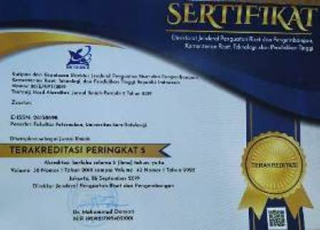PENGARUH PENDAPATAN RUMAH TANGGA TERHADAP KONSUMSI DAGING (SAPI, BABI DAN AYAM ) DI DESA SEA I KECAMATAN PINELENG
Abstract
ABSTRACT
THE EFFECT OF HOUSEHOLD INCOME ON MEAT CONSUMPTION (BEEF, PORK AND CHIKEN) AT THE VILLAGE OF SEA I, PINELENG DISTRICT.This study aims to determine the magnitude of meat consumption (beef, porl and chiken) of household based on income levels in the Village of Sea I, Pineleng district and to determine the effect of household income on meat consumption (beef, porl and chiken) in the Village of Sea I, Pineleng district. Formulation of research problem is how much they purchased meat (beef, porl and chiken) consumption household in the Village of Sea I, Pineleng district. This study was conducted in the Village of Sea I, Pineleng district. Study was conducted using a survey method, and data were obtained through primary data and secondary data. Determination of the location (rural sample) in the study was conducted by purposive sampling method. Number of samples used in this study were 30 people. Data of this study were analyzed by descriptive and mathematical analysis methods. Income indicated the amount of income earned in a month household, whether they were from the household head or sourced from other household members who work and earn income. From the money earned, the highest number of respondents had incomes between 1.000.000 to 3.000.000/month with the percentage of 70 %, while the number of respondents with the smallest income was less than 1.000.000/month with the percentage of 16.67 %. The difference of income held by the respondents in the Village of Sea I, would have an impact on the amount of meat purchases each month. This was in accordance with the opinion Sukirno (2002) stating that most of the disposable income is used to buy food and clothing. Most of the meat consumed by people in the Village of Sea I was pork and chicken meat compared to beef, it was because the price of beef was relatively expensive compared to the price of pork and chicken meat. Based on research results, pork was the most meat consumed by family respondents about 21 families with the percentage of 70 % of respondents, followed by chicken meat about 18 families with the percentage of 60 % of respondents, and beef by 8 families with the percentage of 26 respondents, 67 % of domestic poultry and meat about 6 families with the percentage of 20 % of respondents. Based on the results of research, it can be concluded that household income significantly affect the consumption of meat in the Village of Sea I, Pineleng district and the average consumption of meat in the Village of Sea I, Pineleng district was about 8,9 kg/capita/year, below the national target of 10,3 kg/capita/year.
Key Words : Household income, meat consumption, Sea I Village.
Full Text:
PDFDOI: https://doi.org/10.35792/zot.34.2.2014.5522
Refbacks
- There are currently no refbacks.
ALAMAT REDAKSI:
Fakultas Peternakan Universitas Sam Ratulangi
Jalan Kampus, Bahu Manado, 95115
Telp. 0431-863186, E mail : jzootek@yahoo.com











